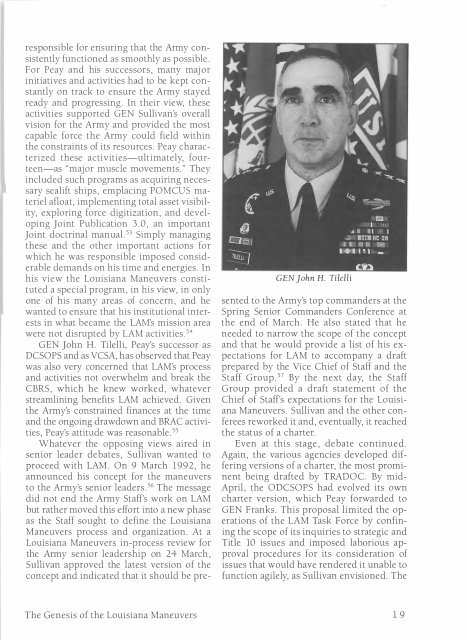The Modern Louisiana Maneuvers - US Army Center Of Military History
The Modern Louisiana Maneuvers - US Army Center Of Military History
The Modern Louisiana Maneuvers - US Army Center Of Military History
Create successful ePaper yourself
Turn your PDF publications into a flip-book with our unique Google optimized e-Paper software.
esponsible for ensuring that the <strong>Army</strong> consistently<br />
functioned as smoothly as possible.<br />
For Peay and his successors, many major<br />
initiatives and activities had to be kept constantly<br />
on track to ensure the <strong>Army</strong> stayed<br />
ready and progressing. In their view, these<br />
activities supported GEN Sullivan's overall<br />
vision for the <strong>Army</strong> and provided the most<br />
capable force the <strong>Army</strong> could field within<br />
the constraints of its resources. Peay characterized<br />
these activities-ultimately, fourteen-as<br />
"major muscle movements." <strong>The</strong>y<br />
included such programs as acquiring necessary<br />
sealift ships, emplacing POMC<strong>US</strong> materiel<br />
afloat, implementing total asset visibility,<br />
exploring force digitization, and developing<br />
Joint Publication 3.0, an important<br />
Joint doctrinal manuaP3 Simply managing<br />
these and the other important actions for<br />
which he was responsible imposed considerable<br />
demands on his time and energies. In<br />
his view the <strong>Louisiana</strong> <strong>Maneuvers</strong> constituted<br />
a speCial program, in his view, in only<br />
one of his many areas of concern , and he<br />
wanted to ensure that his institutional interests<br />
in what became the LAM's mission area<br />
were not disrupted by LAM activities 54<br />
GEN John H. Tilelli, Peay's successor as<br />
DCSOPS and as VCSA, has observed that Peay<br />
was also very concerned that LAM's process<br />
and activities not overwhelm and break the<br />
CBRS, which he knew worked, whatever<br />
streamlining benefits LAM achieved. Given<br />
the <strong>Army</strong>'s constrained finances at the time<br />
and the ongoing drawdown and BRAC activities,<br />
Peay's attitude was reasonable.55<br />
Whatever the opposing views aired in<br />
senior leader debates, Sullivan wanted to<br />
proceed with LAM. On 9 March 1992, he<br />
announced his concept for the maneuvers<br />
to the <strong>Army</strong>'s senior leaders. 56 <strong>The</strong> message<br />
did not end the <strong>Army</strong> Staff's work on LAM<br />
but rather moved this effort into a new phase<br />
as the Staff sought to define the <strong>Louisiana</strong><br />
<strong>Maneuvers</strong> process and organization. At a<br />
<strong>Louisiana</strong> <strong>Maneuvers</strong> in-process review for<br />
the <strong>Army</strong> senior leadership on 24 March,<br />
Sullivan approved the latest version of the<br />
concept and indicated that it should be pre-<br />
<strong>The</strong> Genesis of the <strong>Louisiana</strong> <strong>Maneuvers</strong><br />
GEN John H. TileW<br />
sented to the <strong>Army</strong>'s top commanders at the<br />
Spring Senior Commanders Conference at<br />
the end of March. He also stated that he<br />
needed to narrow the scope of the concept<br />
and that he would provide a list of his expectations<br />
for LAM to accompany a draft<br />
prepared by the Vice Chief of Staff and the<br />
Staff Group 57 By the next day, the Staff<br />
Group provided a draft statement of the<br />
Chief of Staff's expectations for the <strong>Louisiana</strong><br />
<strong>Maneuvers</strong>. Sullivan and the other conferees<br />
reworked it and, eventually, it reached<br />
the status of a charter.<br />
Even at this stage, debate continued.<br />
Again, the various agencies developed differing<br />
versions of a charter, the most prominent<br />
being drafted by TRADOC. By mid<br />
April, the ODCSOPS had evolved its own<br />
charter version, which Peay forwarded to<br />
GEN Franks. This proposal limited the operations<br />
of the LAM Task Force by confining<br />
the scope of its inquiries to strategic and<br />
Title 10 issues and imposed laborious approval<br />
procedures for its consideration of<br />
issues that would have rendered it unable to<br />
function agilely, as Sullivan envisioned. <strong>The</strong><br />
19
















